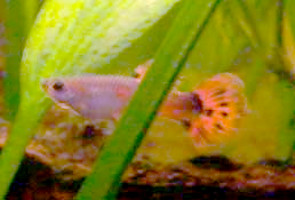| Revision as of 20:36, 24 February 2004 editHadal (talk | contribs)Administrators31,685 edits standardizing taxotable← Previous edit | Revision as of 20:41, 24 February 2004 edit undoHadal (talk | contribs)Administrators31,685 editsm copyeditNext edit → | ||
| Line 17: | Line 17: | ||
| </table> | </table> | ||
| The '''guppy''', alternatively '''guppie''' ('''''Poecilia reticulata''''') is one of the most popular ] in the world. It is a small member of the ] family (females |
The '''guppy''', alternatively '''guppie''' ('''''Poecilia reticulata''''') is one of the most popular ] in the world. It is a small member of the ] family (females 3 centimetres long, males 2 centimetres long) and is therefore ]. It prefers a ] ] and can withstand a surprising degree of ]. Its most famous characteristic is its propensity for breeding. | ||
| The female guppy is a drab brown in colour. The much smaller male naturally has a colourful ] (tailfin), which has been considerably enhanced in shape and colour by ]. | The female guppy is a drab brown in colour. The much smaller male naturally has a colourful ] (tailfin), which has been considerably enhanced in shape and colour by ]. | ||
| Line 25: | Line 25: | ||
| This fish has been introduced to the ] were it lives in the cooling water of the ] Steelmill near ]. The result has been extraodinary; the fish thrive and have increased in size. Fishes of 12 cm are the norm. | This fish has been introduced to the ] were it lives in the cooling water of the ] Steelmill near ]. The result has been extraodinary; the fish thrive and have increased in size. Fishes of 12 cm are the norm. | ||
| Over time, many species are assigned a different ] name. The guppy is no exception: | |||
| *Lebistes reticulatus | *Lebistes reticulatus | ||
| *Acanthocephalus guppli | *Acanthocephalus guppli | ||
Revision as of 20:41, 24 February 2004
| Guppy | |||||||||||||||
|---|---|---|---|---|---|---|---|---|---|---|---|---|---|---|---|
 | |||||||||||||||
| Scientific Classification | |||||||||||||||
| |||||||||||||||
| Binomial name | |||||||||||||||
| Poecilia reticulata |
The guppy, alternatively guppie (Poecilia reticulata) is one of the most popular freshwater aquarium fish species in the world. It is a small member of the Poecilidae family (females 3 centimetres long, males 2 centimetres long) and is therefore live-bearing. It prefers a hard water aquarium and can withstand a surprising degree of salinity. Its most famous characteristic is its propensity for breeding.
The female guppy is a drab brown in colour. The much smaller male naturally has a colourful caudal fin (tailfin), which has been considerably enhanced in shape and colour by selective breeding.
Dr. R. Guppy discovered this tiny fish in Trinidad in 1866, but has escaped from captivity and lives in a feral condition in much of the warmer regions of the world. It has been introduced to some areas to keep down the mosquito population and fight malaria.
This fish has been introduced to the Netherlands were it lives in the cooling water of the Corus Steelmill near IJmuiden. The result has been extraodinary; the fish thrive and have increased in size. Fishes of 12 cm are the norm.
Over time, many species are assigned a different taxonomic name. The guppy is no exception:
- Lebistes reticulatus
- Acanthocephalus guppli
- A. reticulatus
- Girardinus guppii
- G. petersi
- G. poeciloides
- G. reticulatus
- Haridichthys reticulatus
- Heterandria guppyi
- Lebistes poecilioides
- Poecilia poeciloides
- Poecilioides reticulatus.
- For now: Poecilia reticulata
The Guppy aircraft are a series of extremely large wide-bodied aeroplanes that are used to transport oversize cargo, most notably parts for other aeroplanes and smaller rocket stages (ie the third stage of the Saturn V). See Pregnant Guppy, Mini Guppy, and Super Guppy.
The acronym GUPPY in reference to U.S. conventional diesel/electric submarines stands for the Greater Underwater Propulsion Power Program. This series of conversions installed more powerful smaller batteries and involved changes to the hull streamlining and diving control surfaces to effect greater speed underwater.